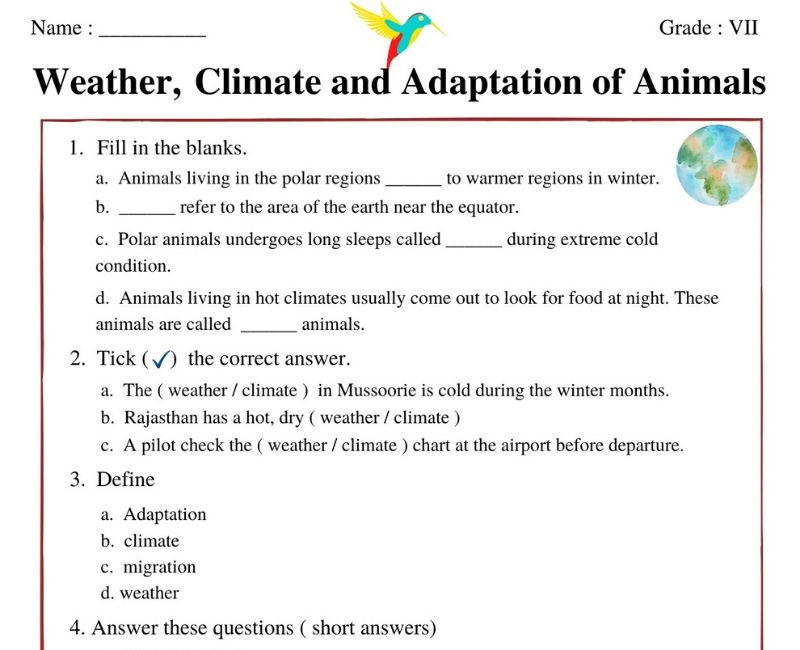Weather Climate and Adaptation Class 7 Worksheet
Embark on an enlightening journey into the intricate world of Weather, Climate, and Adaptation with a worksheet specifically designed for Class 7 students, where the swirling mysteries of the atmosphere unravel one fascinating fact at a time. This worksheet isn’t just a piece of paper; it's a gateway for young explorers to delve deep into the dynamic processes that shape our planet’s weather patterns, understand the subtle and stark differences between weather and climate, and discover the myriad ways in which living organisms adapt to these environmental cues. Designed to captivate and challenge, this Class 7 Weather Climate and Adaptation worksheet serves as the cornerstone for students eager to navigate the complex yet thrilling terrains of earth science.
With every question pondered and activity undertaken, students find themselves immersed in a curated learning experience. The accompanying notes on Weather, Climate, and Adaptation for Class 7 are not merely information; they are narrated stories of our planet's climatic diversity and adaptability. These meticulously prepared notes cover a wide range of key concepts, definitions, and examples, enhancing students’ understanding with rich, contextual knowledge that goes beyond the textbook.
Moreover, an array of meticulously crafted multiple-choice questions on Weather, Climate, and Adaptation shine a light on the students’ grasp of the topic, sharpening their analytical skills and preparing them for various assessments. These MCQs challenge young minds to apply their knowledge practically, ensuring a robust foundation is laid for future scientific inquiries.
Furthermore, a trove of extra questions on Weather, Climate, and Adaptation for Class 7 awaits the curious minds, prepared to test their comprehension levels and push their boundaries of understanding. These extra questions, ranging from straightforward to complex, are designed to stimulate critical thinking and encourage a deeper exploration into the fascinating interplay between the earth’s atmosphere and the life it sustains.
Students, as they navigate through this comprehensive suite of resources, are not just learning about meteorological phenomena and adaptive strategies; they are gearing up to become informed citizens of the world. This educational journey through Weather, Climate, and Adaptation equips them with the knowledge to appreciate the planet’s intricacies and the resilience of its inhabitants, seeding a deep-rooted respect and a sense of responsibility towards Earth and its environment.
FAQs
Q: What is weather and how is it different from climate?
A: Weather refers to the day-to-day conditions of the atmosphere in terms of temperature, humidity, precipitation, wind, etc. Climate, on the other hand, is the average weather pattern over a long period of time (usually 30 years or more) in a particular region.
Q: What is adaptation?
A: Adaptation is the ability of living organisms to adjust to their environment in order to survive and reproduce.
Q: How do animals adapt to different climates?
A: Animals can adapt to different climates in various ways such as changing their physical characteristics (e.g. thick fur for cold climates), modifying their behavior (e.g. hibernation in winter), or altering their metabolism (e.g. using fat stores for energy in times of scarcity).
Q: What are the adaptations of animals in a tropical rainforest?
A: Animals in a tropical rainforest have adaptations such as bright colors to attract mates or warn predators, camouflage to blend in with their surroundings, and the ability to climb trees or glide through the air to move around in the dense vegetation.
Q: Who prepares the red data book in India?
A: The red data book in India is prepared by the Botanical Survey of India (BSI) and the Zoological Survey of India (ZSI) to document the conservation status of various species of plants and animals in the country.
Q: What is the maximum temperature of the day and when does it generally occur?
A: The maximum temperature of the day usually occurs in the afternoon, between 2 pm and 4 pm, depending on the location and season.
Q: What is weathering?
A: Weathering is the process by which rocks and other geological materials are broken down by the action of natural elements such as water, wind, and temperature changes.
Q: What is the meaning of adapts in Hindi?
A: The meaning of adapts in Hindi is अनुकूलित होना.
Q: What are some examples of adaptation in animals?
A: Examples of adaptation in animals include camouflage, hibernation, migration, and changes in physical characteristics such as thicker fur or longer legs.
Q: What is climate change?
A: Climate change refers to the long-term alteration of the Earth's climate due to human activities such as burning fossil fuels and deforestation, resulting in rising temperatures, changes in precipitation patterns, and other impacts on the environment and society.






